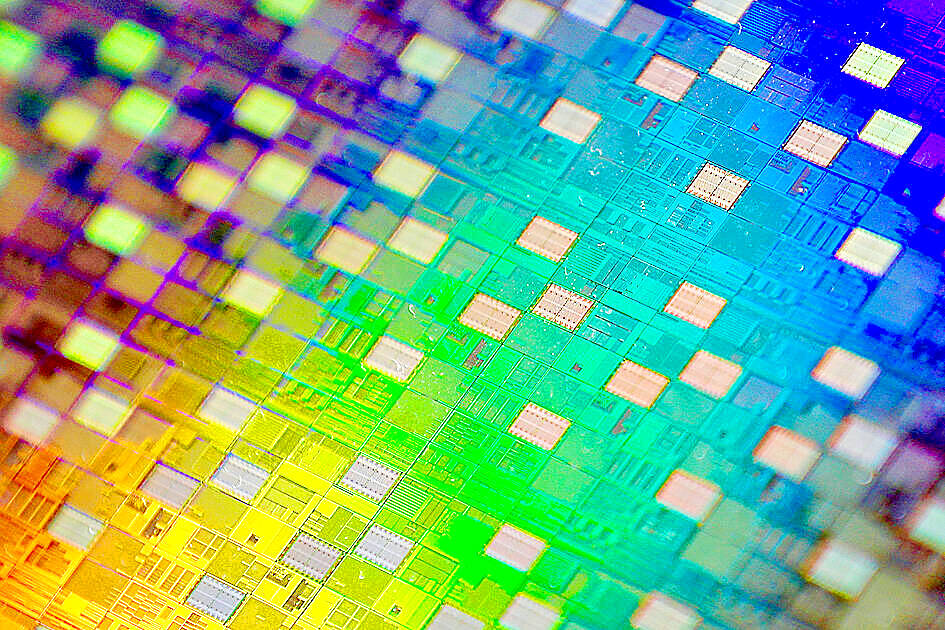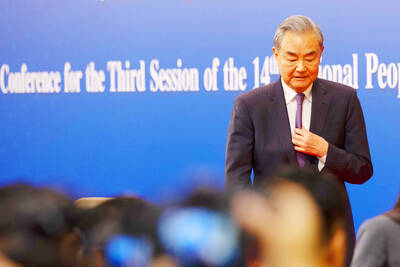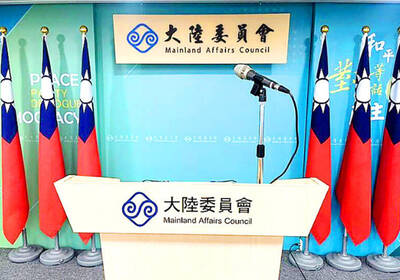A recent meeting of the “Fab 4” alliance focused on establishing an early warning system for the semiconductor industry to improve supply chain resilience, a Ministry of Economic Affairs (MOEA) official said on Saturday.
Responding to reports earlier on Saturday that the four countries in the alliance — Taiwan, Japan, South Korea and the US — held a videoconference, the Ministry of Foreign Affairs confirmed that the meeting was held on Feb. 16.
It was the first formal meeting of the alliance, also known as the “Chip 4,” following a preparatory meeting held virtually in September last year after months of coordination among the four countries, the ministry said.

Photo: EPA-EFE
An MOEA official said that Taiwanese representatives at the one-hour meeting stressed the importance of creating an early warning system that covered all aspects of the complicated semiconductor supply chain, including raw materials and equipment.
The early warning system is critical, given the major chip shortages that occurred during the COVID-19 pandemic and the need for the four nations involved to communicate effectively to predict when other supply chain issues could occur, the official said.
An early warning system would also undoubtedly benefit Taiwanese IC suppliers, and even the local supply chain, the official added.
The US-led Chip 4 alliance is widely seen as a Washington initiative to contain Beijing in the cutting-edge sector.
However, the official said that the one-hour meeting did not touch on export controls or ties with China.
US President Joe Biden’s administration issued sweeping new rules in October last year that include restrictions on the supply of US manufacturers’ most advanced chipmaking equipment to Chinese customers and limits on Americans working for Chinese semiconductor firms, a move aimed at choking off access to certain expertise.
China, the top trading partner of Taiwan, Japan and South Korea, has said that the US effort showed its “selfish hegemonic interest.”
The US has secured an agreement with the Netherlands and Japan to restrict exports of some advanced chipmaking machinery to China.
At the Feb. 16 meeting, the US representatives emphasized the complementary nature of the alliance in the global semiconductor supply chain, with Taiwan and South Korea’s expertise in manufacturing, the US’ upper hand in equipment supplies and IC design, and Japan’s edge in IC material supplies, the MOEA official said.
The meeting was hosted by the American Institute in Taiwan, the de facto US embassy in Taipei, South Korea’s Yonhap News Agency reported.
Additional reporting by Bloomberg

SEPARATE: The MAC rebutted Beijing’s claim that Taiwan is China’s province, asserting that UN Resolution 2758 neither mentions Taiwan nor grants the PRC authority over it The “status quo” of democratic Taiwan and autocratic China not belonging to each other has long been recognized by the international community, the Mainland Affairs Council (MAC) said yesterday in its rebuttal of Beijing’s claim that Taiwan can only be represented in the UN as “Taiwan, Province of China.” Chinese Minister of Foreign Affairs Wang Yi (王毅) yesterday at a news conference of the third session at the 14th National People’s Congress said that Taiwan can only be referred to as “Taiwan, Province of China” at the UN. Taiwan is an inseparable part of Chinese territory, which is not only history but

CROSSED A LINE: While entertainers working in China have made pro-China statements before, this time it seriously affected the nation’s security and interests, a source said The Mainland Affairs Council (MAC) late on Saturday night condemned the comments of Taiwanese entertainers who reposted Chinese statements denigrating Taiwan’s sovereignty. The nation’s cross-strait affairs authority issued the statement after several Taiwanese entertainers, including Patty Hou (侯佩岑), Ouyang Nana (歐陽娜娜) and Michelle Chen (陳妍希), on Friday and Saturday shared on their respective Sina Weibo (微博) accounts a post by state broadcaster China Central Television. The post showed an image of a map of Taiwan along with the five stars of the Chinese flag, and the message: “Taiwan is never a country. It never was and never will be.” The post followed remarks

INVESTMENT WATCH: The US activity would not affect the firm’s investment in Taiwan, where 11 production lines would likely be completed this year, C.C. Wei said Investments by Taiwan Semiconductor Manufacturing Co (TSMC, 台積電) in the US should not be a cause for concern, but rather seen as the moment that the company and Taiwan stepped into the global spotlight, President William Lai (賴清德) told a news conference at the Presidential Office in Taipei yesterday alongside TSMC chairman and chief executive officer C.C. Wei (魏哲家). Wei and US President Donald Trump in Washington on Monday announced plans to invest US$100 billion in the US to build three advanced foundries, two packaging plants, and a research and development center, after Trump threatened to slap tariffs on chips made

CONSISTENT COMMITMENT: The American Institute in Taiwan director said that the US would expand investment and trade relationships to make both nations more prosperous The US would not abandon its commitment to Taiwan, and would make Taiwan safer, stronger and more prosperous, American Institute in Taiwan Director Raymond Greene said. “The US’ commitment to Taiwan has been consistent over many administrations and over many years, and we will not abandon our commitment to Taiwan, including our opposition to any attempt to use force or coercion to change Taiwan’s status,” he said in an exclusive interview with the Liberty Times (the sister newspaper of the Taipei Times) on Friday last week, which was published in the Chinese-language newspaper yesterday. The US would double down on its efforts